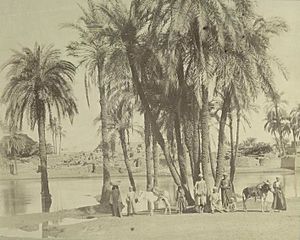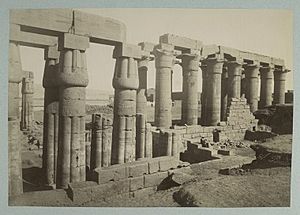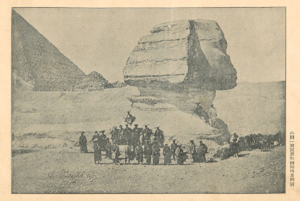Antonio Beato facts for kids
Quick facts for kids
Antonio Beato
|
|
|---|---|

Village of Karnak, photograph by Beato, 1880s
|
|
| Born | 1835 Italy
|
| Died | 1906 (aged 70) |
| Nationality | British, Italian |
| Other names | Antoine Beato |
| Occupation | Photographer |
| Known for | His genre works, portraits, views of the architecture and landscapes of Egypt and the other locations in the Mediterranean region |
| Relatives | Felice Beato (brother); Leonilda Maria Matilda Beato (sister) and James Robertson (photographer) brother-in-law |
Antonio Beato (1835–1906), also known as Antoine Beato, was a famous photographer. He was Italian-British. Antonio was known for his pictures of everyday life, people, and beautiful places. He took many photos of buildings and landscapes in Egypt and other parts of the Mediterranean region.
Antonio was the younger brother of another well-known photographer, Felice Beato. They sometimes worked together. Antonio and Felice were among the first photographers to take many pictures of the "Orient," which means the Middle East and Asia.
Contents
Life as a Photographer
Early Life and Family
We don't know much about Antonio Beato's early life. He was likely born in Italy around 1835. Later, he became a British citizen. His older brother, Felice Beato, was born in Venice, Italy. Their family might have moved to Corfu, an island that was once owned by Venice.
Antonio often used the French version of his name, Antoine Beato. He probably did this because he worked mostly in Egypt. Many people in Egypt spoke French at that time.
Working with His Brother
For a long time, people thought there was only one photographer named "Felice Antonio Beato." This was because some photos were signed "Felice Antonio Beato" or "Felice A. Beato." It seemed impossible for one person to be in Egypt and Japan at the same time!
In 1983, experts discovered the truth. "Felice Antonio Beato" was actually two brothers: Felice and Antonio. They often worked together and shared a signature. This is why it can still be hard to tell which brother took a specific photo.
Antonio likely learned photography from his brother, Felice. Felice met British photographer James Robertson in Malta around 1850. Felice then bought camera gear in Paris. He later traveled with Robertson to Constantinople (now Istanbul) in 1851. Antonio joined them in Malta around 1853.
Capturing the Middle East
By the 1850s, many tourists were visiting the Middle East. They wanted photographs as souvenirs. Antonio and Felice were part of a group of early photographers who went to the East. They wanted to meet this demand.
Other famous photographers, like Félix Bonfils and the Zangaki brothers, were also working in Egypt. Many of these photographers worked together. Antonio and his brother were among the first to take and sell many photos in the Middle East.
In late 1854 or early 1855, Antonio's sister, Leonilda, married James Robertson. He was their brothers' business partner. The company was sometimes called "Robertson, Beato and Co." Many believe "and Co." referred to Antonio.
In 1858, Antonio joined Felice in Calcutta, India. Felice had been taking photos of the Indian Rebellion of 1857. Antonio also photographed in India until late 1859. He then left for Malta, likely because of his health.
Life in Egypt
Antonio Beato moved to Cairo, Egypt, around 1859 or 1860. He stayed there for two years. Then, in 1862, he moved to Luxor and opened his own photo studio. He worked there until he died in 1906.
In Luxor, Antonio took many pictures for tourists. He photographed the people and ancient buildings of the area. In the late 1860s, he worked with a French photographer named Hippolyte Arnoux.
Antonio's photos of Egypt were special. Other photographers often focused on grand monuments. But Antonio loved to photograph scenes of everyday life. He showed what life was like for ordinary people.
In 1864, Antonio took photos of a Japanese group visiting Egypt. They were on their way to France. At this time, his brother Felice was living and photographing in Japan.
Antonio Beato passed away in Luxor in 1906. After his death, his wife announced it and offered his house and photography equipment for sale.
Famous Photo Collections
Antonio Beato's photographs are kept in many important museums and collections around the world. Here are some of them:
- The Metropolitan Museum of Art, New York
- The Royal Collection, London
- J. Paul Getty Museum, Los Angeles
- Conway Library, The Courtauld Institute of Art, London
- Brooklyn Museum, New York
- American Academy in Rome, Rome
- Harvard Art Museums, Mass.
- National Gallery of Canada, Ottawa
- Art Institute of Chicago, Chicago
- Victoria and Albert Museum, London
See also
- History of photography
- List of Orientalist artists
- Orientalism



